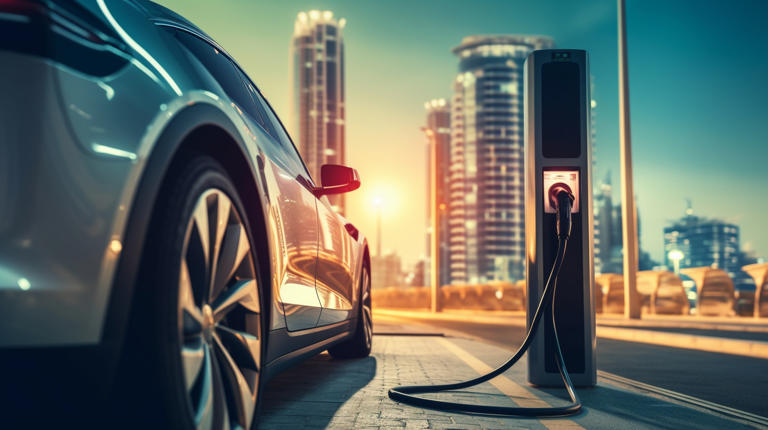Four years ago, General Motors established an ambitious objective: The company intended to transition entirely to electric vehicles by 2035.
Company representatives assert that the organization continues to pursue that objective. At the same time, it advocated for the repeal of California’s prohibition on the sale of new gas cars to the Senate, which was scheduled to take effect in 2035. California’s policy should have theoretically contributed to GM’s transition.
GM even solicited employees to participate in the lobbying campaign. The Wall Street Journal reported that the company issued an email to its employees stating, “We require your assistance.” “Our business is significantly threatened by emissions standards that are not in accordance with market realities, as they undermine consumer choice and vehicle affordability.”
READ MORE: The Number Of Electric Vehicles Is Rapidly Declining
Lobbying was successful. Yesterday, the Senate voted to revoke an Environmental Protection Agency waiver that permitted California to establish clean air regulations that were more stringent than national standards. (Congress arguably lacked the legal authority to revoke the waiver; further discussion on this matter will be provided at a later time.)

“GM is grateful for Congress’ initiative to reconcile emissions standards with the current market conditions,” the company stated in a statement. We have long supported a single national standard that will enable us to remain competitive, continue to invest in U.S. innovation, and provide customers with a wide range of gas-powered and electrified vehicles.
Mary Barra, the CEO of General Motors, has expressed her conviction that the company is committed to an all-electric future. The organization, which initiated a significant investment in battery design in 2018, allocated $11 billion to electric vehicle infrastructure between 2020 and 2024. Co-owned with LG Energy, it operates a substantial battery facility in the vicinity of Nashville and another in Ohio, which produces thousands of battery cells per minute. It is in a race to reduce the cost of batteries, which is the most significant determinant in the overall cost of EVs.

GM sold 31,887 electric vehicles (EVs) in the United States during the first quarter of this year, a 94% increase from the same period last year. It is currently the second-largest seller of electric vehicles (EVs) in the United States, and it is rapidly surpassing Tesla. The company intends to produce nearly twice as many electric vehicles (EVs) this year as it did in the previous year. The Chevy Equinox EV, which is presently the most affordable electric vehicle in the country, is one of the 11 models available. The Chevy Bolt, a popular and affordable electric vehicle, will be reintroduced later this year.
READ MORE: An Electric Vehicle Rival Of Tesla Produces Batteries With A Range Of Slightly More Than 630 Miles
However, the company contends that the clean car rule in California is progressing at a higher pace than the market demand. The regulations establish annual objectives that manufacturers are required to achieve. A manufacturer is required to sell 35% of its cars in the state as zero-emission vehicles for the 2026 model year, or else they will be subject to a sanction. The target is to increase to 43% in 2027, 51% in 2028, and continue until all new vehicles are zero-emission by 2035. About 25% of the new vehicles registered in California last year were electric. The percentage of electric vehicle sales may decrease this year due to the fact that a significant number of purchasers have abandoned Tesla. GM declined to provide an update on its expectations for the 35% target for model year 2026 vehicles in the state.

Massachusetts, New York, Oregon, Vermont, and Washington have implemented comparable annual objectives to California’s regulation. Currently, the percentage of electric vehicle sales in those jurisdictions is even lower. Car manufacturers assert that it would be unfeasible for them to promptly achieve the model year 2026 targets that those states mandate.
Critics contend that manufacturers are partially accountable for diminished demand. Dan Becker, director of the Safe Climate Transport Campaign at the nonprofit Center for Biological Diversity, compares the situation to that of a child who says, “I didn’t study for the test, and it’s unfair that you’re giving me a bad grade.” Becker also emphasizes that General Motors employs “the best engineers in the world.” They possess the ability to produce vehicles that are both consumer-friendly and compliant with industry standards. Additionally, they have elected not to advertise their electric vehicles. In the United States, the auto industry allocates $14 billion annually to advertising and other marketing initiatives. Only a small portion of that is allocated to the promotion of electric vehicles.
EVs are confronted with additional significant obstacles. Companies that have not yet sold 200,000 EVs will be able to continue to qualify for the credits until the end of 2026; GM has already exceeded that limit. The House recently voted to phase out the $7,500 tax credits for the purchase or lease of new EVs. Additionally, the House measure terminates a $4,000 tax credit for used cars that was implemented in the Inflation Reduction Act, as well as an additional tax credit for home chargers. The tax credits are essential because electric vehicles have not yet achieved price parity with gasoline-powered vehicles.

Additionally, tariffs are imposing substantial expenses on automobile manufacturers. The California regulations have the potential to result in billions of dollars in losses for the company, which is already experiencing a decline in profits due to tariffs. This money is essential for the company to continue investing in the development of electric vehicles (EVs) in order to reduce costs. Despite the fact that costs are decreasing as production scales up and technology continues to advance, GM is still losing money on EV production.
The Senate verdict on California is not conclusive. The Senate parliamentarian determined that Congress lacked the authority to revoke the waiver that permits California to establish its own clean air regulations. The Congressional Review Act, the legislation that the Senate employed to revoke the waiver, does not include waivers. (The waiver was also granted in 2022 and would not be deemed recent; the CRA allows Congress to overturn recent laws with a simple majority vote.)
Becker asserts that Congress is not permitted to modify laws incrementally by stating, “Oh, well, we really intended it to be this.” “They are opening a Pandora’s box.” If the CRA is not restricted to regulations, you have unlocked the possibility of undoing the congressional action. This includes corporate mergers that are permitted by the Securities and Exchange Commission, cost-of-living adjustments by various agencies, and offshore drilling permits. The ultimate application of this action is uncertain. Additionally, the Republicans will not maintain their position of authority perpetually.
Now, California intends to file a lawsuit against the Trump administration upon Trump’s approval of the legislation. Becker asserts that this will induce industry uncertainty. “They continue to assert that they desire certainty.” Additionally, they are eliminating it by requiring Congress to implement an unlawful mechanism to eliminate safeguards for individuals with lung conditions.
In the interim, the expansion of electric vehicles (EVs) is accelerating in countries other than the United States. It is anticipated that over one in four vehicles sold worldwide this year will be electric vehicles. More than half of the new cars sold in China last year were all-electric. Last month, electric vehicles comprised 97% of all automobiles sold in Norway. American manufacturers will be disadvantaged as federal support in the United States reverses.
Step into the ultimate entertainment experience with Radiant TV! Movies, TV series, exclusive interviews, live events, music, and more—stream anytime, anywhere. Download now on various devices including iPhone, Android, smart TVs, Apple TV, Fire Stick, and more!


